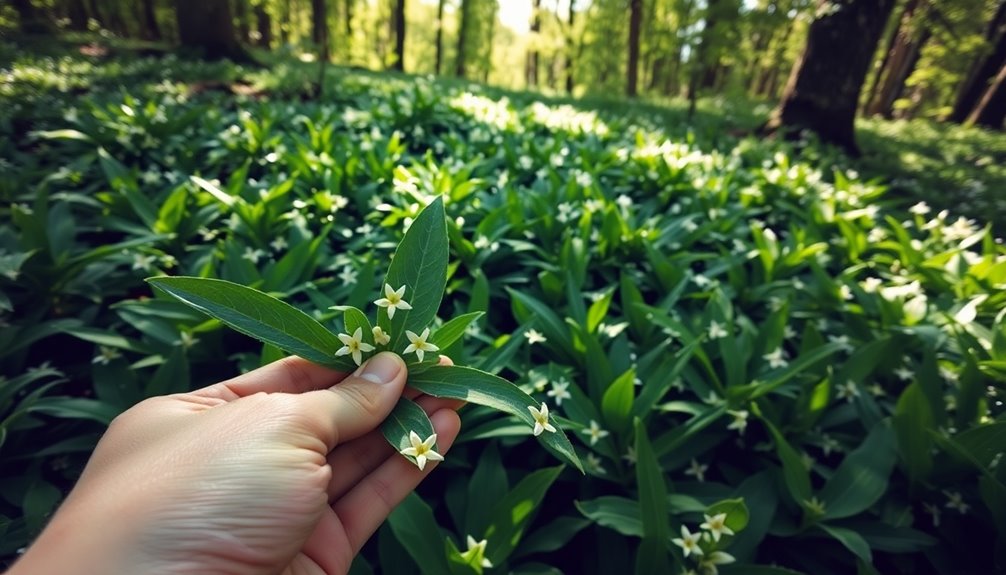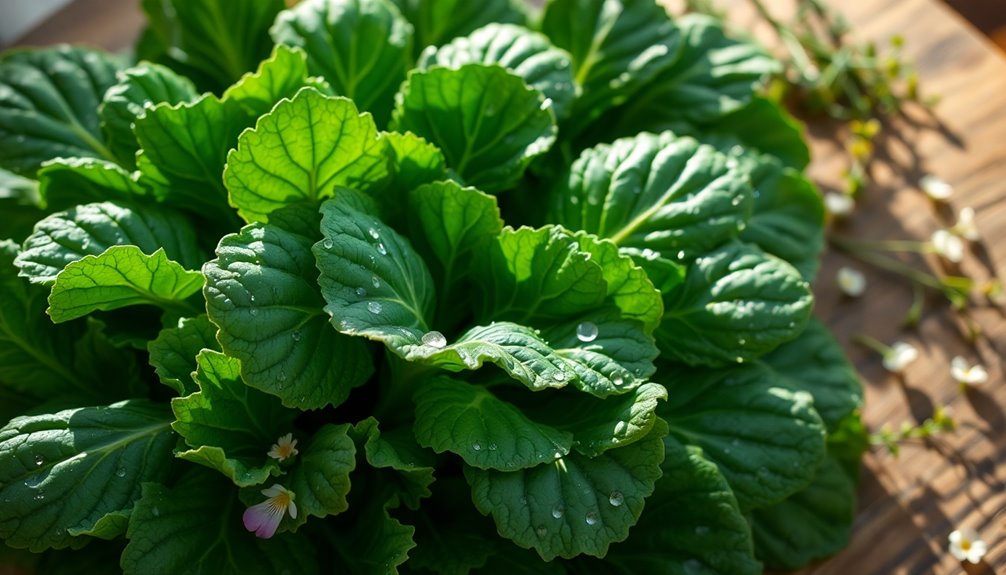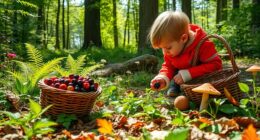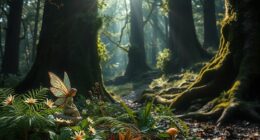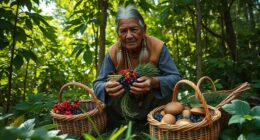Picture yourself strolling through the forest, taking in the crisp air and stunning views. All of a sudden, you come across a vivid green plant with appealing leaves. It appears to be tasty, but it’s unfamiliar to you. Would it be wise to consume it simply because it’s a wild plant?
But here’s the thing: not all wild plants are safe. While many are harmless and tasty, there’s one plant you should always avoid. And that plant is…
This plant is very dangerous and eating it can harm you. Its lush green leaves and appealing look might trick you into thinking it’s safe. However, it’s hiding a deadly secret behind its innocent look.
To stay safe, you must learn to identify this plant. Knowing how to tell it apart from others can protect you in the wild. Initially, spotting the differences may be hard. But with the right info and advice, you can keep yourself safe while adventuring.
Key Takeaways:
- Not all wild plants are safe to eat.
- There is one wild plant that is highly toxic and should never be consumed.
- Identifying the dangerous plant is essential for your safety.
- Looks can be deceivable, so it’s crucial to know how to recognize the toxic plant from others.
- Always be careful about your health when exploring nature.
Toxic Wild Plants that Resemble Edible Counterparts
When you’re out in the wild, it’s very important to know about the toxic plants. They look a lot like the ones you can eat. Eating the wrong plant by mistake can make you very sick. So, learning about these dangerous plants is key to staying safe.
It can be hard to tell toxic plants from the ones that are safe to eat. They might look the same in color, shape, and overall appearance. This could trick even those who are good at finding food in the wild. To avoid mistakes, it’s important to be extra careful and know exactly what you are picking.
Deceptive Visual Similarities
These dangerous plants mimic their safe relatives to trick animals and people. This way, they get picked and spread around. There are some toxic plants that look a lot like the ones we can eat, for example:
- Toxic Wild Mushroom vs. Edible Mushroom: Some bad mushrooms look like good ones. The death cap mushroom (Amanita phalloides) looks like the edible paddy straw mushroom (Volvariella volvacea). A small mistake can cause big problems. Knowing your mushrooms well is very important.
- Poison Hemlock vs. Edible Parsley: Poison hemlock (Conium maculatum) looks a lot like parsley with its delicate leaves and white flowers. It’s very important to be sure of what you’re picking when looking for greens in the wild.
- Water Hemlock vs. Edible Wild Carrot: Water hemlock (Cicuta spp.) looks similar to the edible wild carrot, also known as Queen Anne’s lace (Daucus carota). This plant is very dangerous if eaten.
Learning a lot about dangerous plants and their edible look-alikes is how you avoid trouble. Through good education and practice, you can tell them apart. This know-how lets you enjoy nature more safely.
Takeaway
“Looks can be deceiving in the wild. Dangerous plants can look like safe ones. Spending time to learn which plants are harmful is key for a safe and fun time outdoors.”
Knowing about toxic plants and how they look helps you stay safe. This knowledge reduces the chance of eating something harmful. It makes outdoor activities safer for you and everyone who loves nature.
Giant Hogweed: A Deceptively Dangerous Plant
Giant hogweed looks a lot like the wild carrot. It might seem harmless, but it’s actually quite dangerous. This plant has a chemical that can badly hurt your skin when sunlight hits it.
Touching giant hogweed can cause your skin to blister and burn in a painful way. This reaction can even leave scars or cause blindness if it gets in your eyes. It’s very important not to touch or eat any part of this plant.
To stay safe, it’s crucial to know how to spot giant hogweed. It can get up to 15 feet tall and has thick, hollow stems. It also has huge leaves and white flowers that look like umbrellas up to 2 feet across. Recognizing these features helps tell it apart from safe plants.
It’s best to avoid giant hogweed altogether. If you see it, tell local officials or environment groups so they can safely remove it. Keeping away from this plant is key to staying safe.

| Identification Features | Possible Effects |
|---|---|
| Thick hollow stems | Severe skin reaction |
| Large deeply lobed leaves | Painful blisters and burns |
| White umbrella-shaped flower clusters | Permanent scarring and potential blindness |
Canada Moonseed: Not Your Average Grape
The Canada moonseed is a fascinating plant. It has leaves and fruits that look like grapes. But, it’s not safe to eat like grapes.
To stay safe, it’s crucial to tell it apart from edible grapes. You need to look closely at the seeds.
Unlike grapes with their round, pitted seeds, moonseeds have seeds shaped like a crescent. This key detail will help you spot the Canada moonseed. It keeps you away from danger.

| Canada Moonseed | Edible Grape |
|---|---|
| Possibly fatal if consumed | Safe to eat |
| Grape-like leaves and fruits | Grape-like leaves and fruits |
| Crescent-shaped seeds | Round, pitted seeds |
Knowing the difference between Canada moonseed and edible grapes is a lifesaver. Always be careful picking wild plants. Don’t eat them unless you’re sure they’re safe.
Horse Nettle: A Tomato Look-Alike with Poisonous Fruits
Horse nettle might look like tomatoes, with red fruits and green leaves. But it’s not just any plant. Unlike tomatoes, horse nettle is poisonous and harmful to health.
It’s tempting to try the fruits that look like tomatoes, but don’t. Eating them can cause stomach pain, nausea, and vomiting. Be careful not to consume any part of this plant.
Knowing how to spot horse nettle is key for safety. It can grow three feet tall, has hairy stems, and leaves with sharp spikes. Its fruits look like cherry tomatoes but are dangerous to eat.
How to Identify and Avoid Horse Nettle
To spot horse nettle, look for these signs:
- Height: It grows up to three feet tall.
- Stems and leaves: These parts are hairy and have sharp prickles.
- Fruits: They’re small, round, and look like cherry tomatoes, but are unsafe to eat.
If you see a plant that looks like a tomato, be cautious. Remember, horse nettle can be harmful. Make sure to keep it away from children and pets.
“Although horse nettle’s fruits may look tempting, they’re filled with toxins. Always be careful and avoid this plant to stay safe.”
To help you know what it looks like, see the image below:
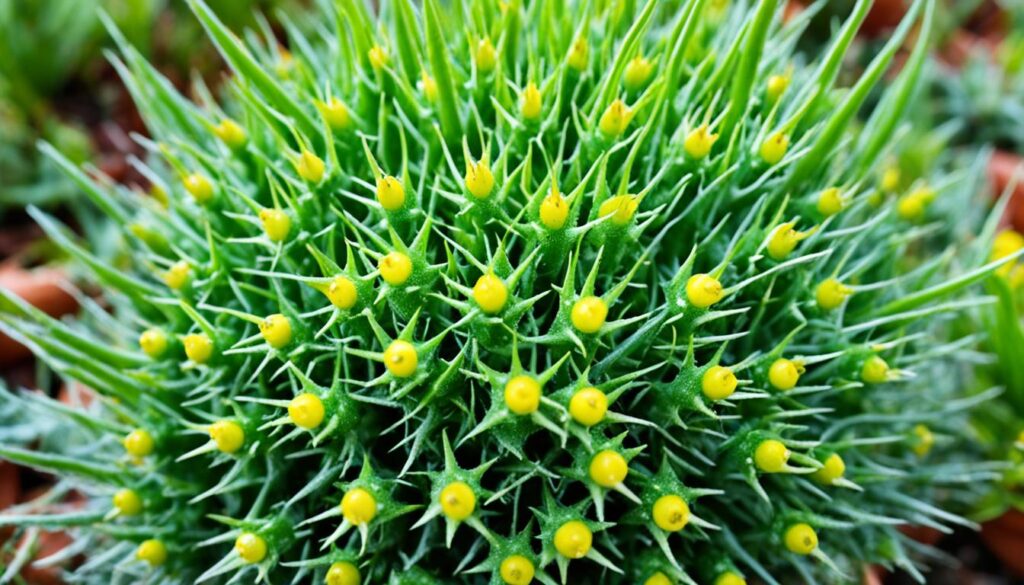
Pokeweed: Berries That Are Harmful to Humans
Pokeweed berries look tempting but are very dangerous. They seem appetizing but are packed with toxins that can harm or even kill humans. Eating even a tiny amount can cause serious health issues.
Pokeweed berries pose a big risk to our health. Eating them can upset your stomach, making you feel sick or throw up. They have a toxin that can mess up your heart, causing it to beat weirdly or even stop.

Cooking or washing pokeweed berries doesn’t make them safe. They should never be eaten, no matter what.
It’s key to know what pokeweed plants and their berries look like. They have bright green leaves and dark purple berries. You can find them in fields, by roads, or at the edge of forests across the U.S.
Distinguishing Pokeweed from Other Berries:
- Pokeweed berries are bigger than blueberries and shiny.
- They grow in clusters and turn dark purple or black when ripe.
- Their stems are a unique reddish-pink color.
We must teach everyone about the dangers of pokeweed berries. When looking for wild berries, only choose ones you know are safe. Your health is most important.
Poison Ivy, Oak, and Sumac: Avoid the Itch
Poison ivy, poison oak, and poison sumac are plants to watch out for outside. These plants have urushiol, causing allergic reactions in many. Recognizing and avoiding these plants helps prevent discomfort.
The urushiol oil from these plants can cause an allergic reaction. Symptoms include itching, redness, swelling, and blisters. Reactions can begin within hours or days, depending on how sensitive you are.
Remember, touching items that have touched these plants can cause reactions, too. Always be careful with clothes, tools, or pets that might have been in contact with them.
Identifying Poison Ivy, Oak, and Sumac:
Knowing what these plants look like is important:
- Poison Ivy: Has three leaflets with jagged edges. Leaves turn from green to reddish in the fall.
- Poison Oak: Also has three leaflets, but they have lobed edges, like an oak leaf.
- Poison Sumac: This shrub or small tree has 7-13 leaflets on each stem. It grows in wet areas.
To stay safe, remember the phrase, “Leaves of three, let it be!” This is a reminder of poison ivy and oak’s key feature.
If you touch poison ivy, oak, or sumac, act fast to lessen the reaction:
- Wash the area with soap and water quickly. Removing some urushiol oil can decrease the reaction.
- Don’t scratch the rash. It can make things worse and lead to infection.
- Use calamine lotion or hydrocortisone cream to help with itching and calm the skin.
- See a doctor if the reaction is bad or covers a lot of your body.
Being smart about poison ivy, oak, and sumac lets you enjoy the outdoors safely.

Wild Cherry: Beware of Cyanide
Wild cherry trees give us delicious cherries loved by people and animals. But, you need to be careful around these trees because some parts are poisonous. Specifically, wild cherry tree leaves have lots of cyanide, a deadly toxin.
When you eat these leaves or crush the cherry pits, cyanide gets released. This is toxic to both humans and animals.
It’s okay to eat the cherries, but stay away from the leaves and pits. The cyanide in them can cause serious health problems if you eat them.
If you see a wild cherry tree while outside, you can enjoy its beauty and the cherries safely. But, never eat the leaves or try to use the pits.
Being cautious is key. The dangers of eating wild cherry leaves or pits are bigger than any benefits.
| Wild Cherry: Beware of Cyanide |
|---|
 |
Key Takeaways:
- Wild cherry trees offer yummy cherries, but be careful with other parts of the tree.
- The leaves of wild cherry trees are full of cyanide, which is poisonous.
- Crushing cherry pits or eating the leaves releases cyanide, posing a risk.
- To stay safe, avoid touching the leaves and pits of wild cherry trees.
Virginia Creeper: Not to be Confused with Poison Ivy
Identifying wild plants requires focus on small details. The Virginia creeper often gets mixed up with poison ivy. Though they look alike, knowing the difference is very important because it can prevent bad outcomes.
Virginia creeper berries are not safe to eat. They are poisonous and can be deadly. The berries have toxins that can cause serious health issues if eaten.
Knowing how to tell Virginia creeper and poison ivy apart is crucial. Both have three-leaf clusters, but there are clear differences that can help you identify them correctly.
Key differences:
- The leaf shape of Virginia creeper is more elongated and ends in a point, which is different from the rounded and notched leaves of poison ivy.
- Leaf arrangement in Virginia creeper is in opposite pairs, whereas poison ivy leaves grow alternating on the stem.
- Berries of Virginia creeper are dark blue or black, looking like small grapes. Poison ivy berries are white or off-white and less visible.
Learn the specific traits of Virginia creeper and poison ivy to tell them apart. It’s smart to be cautious with wild plants.

Enjoying the outdoors and its plants is rewarding, but safety and identification are key. Don’t confuse Virginia creeper with poison ivy, as it could be dangerous. Be aware, careful, and appreciate nature with responsibility.
Nightshade: The Dangerous Look-Alike
Nightshade plants have shiny black berries that might look tempting. But don’t be fooled. These berries can be very harmful because they have a lot of toxic alkaloids.
It’s not common to find the most poisonous nightshades in the wild. Yet, knowing how to tell them apart from safe berries is key. This knowledge can stop you from eating something dangerous.
“Nightshade plants, such as belladonna, have tropane alkaloids. These chemicals can cause fast heartbeats, dilated pupils, and hallucinations if eaten.”
Being safe while outside means learning about nightshade’s unique features. Spotting things like the plant’s leaves, flowers, and how it grows helps. It’s best to be careful when figuring out if a plant is toxic.
Recognizing Nightshade:
- The leaves of nightshade plants are lobed and dark green. They look like hearts or arrows.
- Look for small, star-shaped flowers on nightshade plants. They’re a clue.
- Notice the growth habit of the plant. Nightshades can spread along the ground or grow upright or vine-like.
Identify these features correctly to stay safe. If you’re not sure about a plant, ask a local expert or botanist for help.
Remember, while nature is amazing, it’s also home to dangers. Learn to spot nightshade and other harmful plants. This way, you can enjoy nature safely.

Buckeye: A Tree with Poisonous Nuts
The buckeye tree is part of the Hippocastanaceae family and is known scientifically as Aesculus. These trees are beautiful, with lovely foliage and flowers. However, their nuts are very poisonous because they contain toxic alkaloids.

Eating buckeye nuts is dangerous. These nuts have toxic alkaloids that can make you very sick if you eat them. It’s important never to touch or eat any part of the buckeye tree. This includes the nuts, leaves, and bark.
It’s easy to confuse buckeye nuts with edible chestnuts. Mistaking them can cause accidental poisoning. Knowing how to tell them apart is key to keeping everyone safe.
Buckeye nuts have alkaloids that can make you feel very ill. Symptoms include nausea, vomiting, diarrhea, and dizziness. In the worst cases, it can even cause paralysis. Always stay away from these toxic nuts.
If you see a buckeye tree while outside or in nature, admire it from afar. Don’t collect or eat the nuts, as they’re harmful.
When dealing with unknown plants or trees, it’s safer to be cautious. Knowing the dangers of plants like the buckeye tree helps keep you safe. This lets you enjoy nature without risking your health.
Conclusion
It’s key to know about toxic wild plants that look like the ones we can eat. Learning to spot them stops us from accidentally eating something harmful. When you’re out wild foraging, always be safe and know what you’re picking to keep the experience fun and safe.
Getting to know the looks and traits of toxic plants helps you stay safe in nature. It’s smart to learn about the poisonous plants in your area. And be extra careful in new places.
If you love foraging or are new to it, being careful is key. Get advice from those who know a lot or look up reliable info. This will make you better at understanding wild foraging and its risks.
The world of wild plants is full of amazing things to discover. By being well-informed and using safe foraging methods, you can enjoy what nature has to offer. And you’ll stay clear of the risks from toxic plants.





